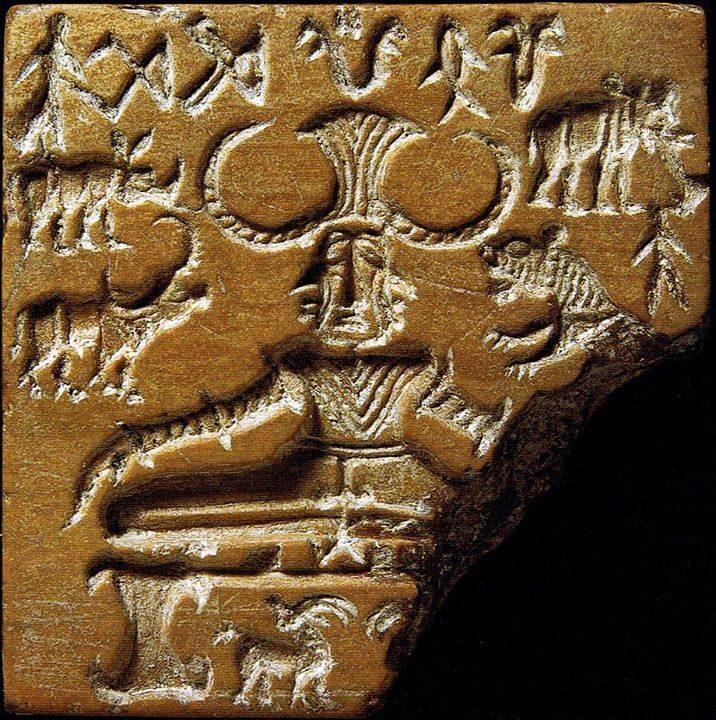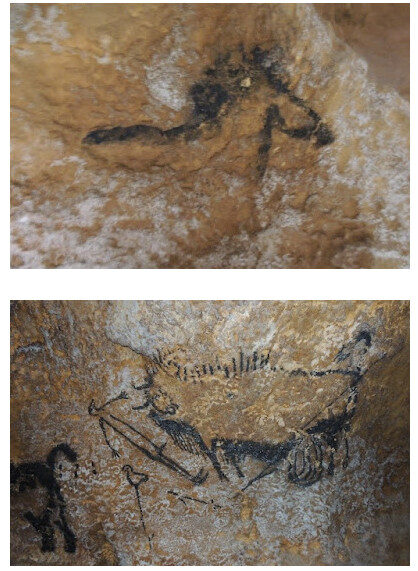Many other Master-of-Animals figures are known; see here.
The problem with this Master-of-Animals is that the zodiac doesn't conform to one we know. At 2000 BCE the solsticial/equinoctial constellations are; Taurus (spring), Capricornus (winter), Libra (autumn) and Leo (summer). Thus, using the Greek zodiac we should have a bovine, sea-goat, scales and feline, respectively. Of course, the scales are not zoomorphic and the sea-goat is specific to lower Mesopotamia. So we shouldn't expect to see them anyway. So this leaves the bovine and feline symbols, which are consistent with the Greek zodiac. But we also have an elephant and rhino. Can these represent zodiacal constellations?
Well, let's consider the Lascaux Shaft Scene, which is exactly 13,000 years (0.5 great years) older, and therefore we can expect the summer/winter and spring/autumn symbols to have switched places.
Here, we also have bovine and rhino forms, in addition to a bird and a horse on the back wall. Again, 4 animal symbols plus a dying man, similar to Pillar 43 at Gobekli Tepe. Now, according to my 2019 paper with Alistair Coombs, the bull symbolises pseudo-Capricornus, not Taurus, just as at Gobekli Tepe. Here, it is supposedly the rhino that represents Taurus (or something like Taurus). And the horse on the back wall symbolises pseudo-Leo while the bird symbolises pseudo-Libra. So, let's just summarise this;
| - | Summer | Autumn | Winter | Spring |
| Pashupati Seal | Tiger (Leo) | Elephant (Libra?) | Bull (Capricornus) | Rhino (Taurus) |
| Lascaux Cave | Bull (Capricornus) | Rhino (Taurus) | Horse (Leo) | Bird (Libra?) |
In the 2017 paper with Dimitrios Tsikritsis, we deduced the bull symbolises Capricornus at Gobekli Tepe. And this also seems to be the case at Catalhoyuk. It makes sense too at Lascaux, where the entrance to the cave, the Hall of Bulls, faces the setting sun on the summer solstice, i.e. it faces Bull constellation. So, does the bull also symbolise Capricornus on the Pahupati Seal? Were the Indus Valley civilisation using an ice-age zodiac? I suspect they were, except for the tiger as Leo.
This would mean the elephant as Libra is a relic from the ice age. Indeed, there are plenty of elephant/mammoth paintings in ice-age caves, and the ones that have been radiocarbon dated are all consistent with Libra. However, in the Lascaux Shaft Scene the bird seems to represent Libra instead, which is consistent with Pillar 43 at Gobekli Tepe.
The horse as Leo in the Lascaux Shaft Scene is also a very nice fit. The horse and Leo look very similar. Notice how the horse also has no legs, like the constellation in Stellarium.
So it seems we can interpret the Pashupati Seal with an ice-age zodiac, except where the tiger is Leo (consistent with the Greek zodiac).
By the way, the rhino appears on many seal stamps from the Indus Valley civilisation. Often, it is called a mythical 'unicorn' because the symbol is usually drawn with only one horn. But clearly, the picture is of a rhino, not a unicorn. This is very obvious. So, it appears the Indus Valley seal stamps with rhino/unicorn pictures are all using the same system of zodiacal dating, as predicted by Gurshtein, where the rhino symbolises Taurus, which is the spring equinox constellation at the time.





Reader Comments
Excellent example of today's post-normal, concensus science.
Though I think like in the medical business, this is a con game. "Trust me, I am the authority". Indoctrinated in the hypnotized population from childhood on. In fact, most of this are speculations. Which is o.k. for a starting point (a.k.a. working hypothesis), but will become problematic if you build narratives and dogmas around it.
Like, creating an "Out Of Africa" theory from one incomplete and dilapidated set of humanoid bones ...
Some insecure little person gets their Phd, which gives their insecure little thoughts some gravitas. Now they feel empowered and will not give up their thoughts, going so far as to attack and belittle anyone questioning their insecure little thoughts.
A vicious circle brought about by our systems of 'education'.
+ so called "Peer Reviewed" Papers , and Published in "Scientific" Journals , the principal of Rinse & Repeat...
Best of the Web: Complex systems won't survive the competence crisis
At a casual glance, the recent cascades of American disasters might seem unrelated. In a span of fewer than six months in 2017, three U.S. Naval warships experienced three separate collisions...